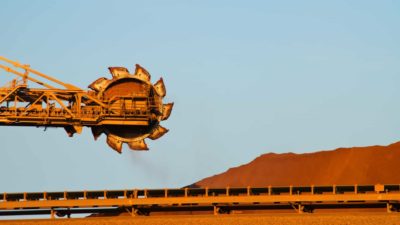The BHP Group Ltd (ASX: BHP) share price dropped in FY22. It wasn't just a small falter either; it was a fall of around 17.5%.
It dropped enough that the total shareholder return — the combined share price and dividend total return — was negative in the mid-single-digits, according to CMC Markets. That's despite the large dividends the miner paid.
As a resource business, changes in commodity prices can have a significant influence on what investors believe a company can achieve in terms of future revenue, net profit after tax (NPAT), cash flow and dividends. Each of those financial measures can also have a sizeable influence on the BHP share price.
As it turned out, the BHP business underwent quite a few changes during FY22.
Volatile iron ore price
The iron ore price was particularly strong at the start of FY22. At one stage, it was above US$200 per tonne amid strong demand from China, the main buyer of iron ore.
BHP generates a significant portion of its profit from iron ore, so changes in the iron ore price can have a sizeable impact on the profitability of the business.
In the first half of FY22, BHP's iron division generated almost US$10 billion of the US$15.6 billion continuing operations earnings before interest and tax (EBIT). In FY21, iron ore generated US$24.3 billion of the US$30.3 billion EBIT.
By November 2021, the iron ore price had fallen to below US$100 per tonne. This also saw the BHP share price fall below US$36 briefly.
While the iron ore price is still above US$110 per tonne currently, it has fallen by more than US$20 per tonne over the last month, reducing the potential profit from BHP's iron division.
Petroleum divested
Investors also have to weigh up what BHP's profitability will be going forward without the company's gas and oil segment after BHP divested it to Woodside Energy Group Ltd (ASX: WDS).
The plan was that BHP shareholders would get Woodside shares as payment for the BHP division. At the time of the announcement, it was expected to create a global top 10 energy company by production and the largest energy company listed on the ASX.
This combined company is expected to have "a high margin oil portfolio, long life LNG (liquified natural gas) assets and the financial resilience to help supply the energy needed for global growth and development over the energy transition".
However, that segment is no longer in the BHP portfolio and not generating the earnings it was when it was part of the BHP business.
Big FY22 dividend expected
FY22 is now over but shareholders will still benefit from the payment of the final dividend adding to the total FY22 dividend, which is expected to be large.
Indeed, CMC Markets suggests BHP could pay a total FY22 dividend of $4.91 per share, equating to a grossed-up dividend yield of 17.5%.
The broker Macquarie isn't expecting the dividend to be quite as big, however. It's projecting a grossed-up dividend yield of 15.8% from BHP for FY22.









